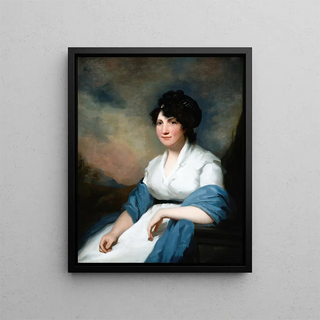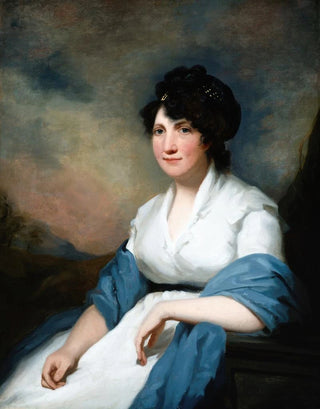Art print | Lady Delves Broughton - Sir Henry Raeburn


View from behind

Frame (optional)
Lady Delves Broughton - Sir Henry Raeburn – Captivating introduction
The "Lady Delves Broughton" painting by Sir Henry Raeburn is an iconic work that embodies the elegance and refinement of 18th-century British portraiture. This painting, depicting Lady Delves Broughton, is much more than a simple representation of a noble lady: it reflects an era where art and society were deeply intertwined. In this piece, Raeburn succeeds in capturing not only the external beauty of his subject but also her inner essence, making this portrait a true testament to its time. The soft light bathing Lady Delves's face, along with the meticulous details of her attire, invites the viewer to immerse themselves in a universe where each brushstroke tells a story.
Style and uniqueness of the work
Raeburn's style is distinguished by his ability to blend realism and idealization. In "Lady Delves Broughton," he uses a rich and subtle color palette, creating an atmosphere that is both warm and intimate. The drapery of the lady's clothing, carefully painted, evokes a sense of movement and fluidity that brings the work to life. Raeburn excels in depicting textures, whether the softness of skin or the richness of fabrics, which adds depth and an almost tactile dimension to the painting. Lady Delves's posture, both elegant and natural, demonstrates unparalleled mastery in portrait art, where the artist manages to transcend mere representation to offer a true visual experience.
The artist and his influence
Sir Henry Raeburn, a key figure in Scottish art, left his mark on his era through his innovative technique and psychological approach to portraits. Through his works, he captured the spirit of his contemporaries, endowing them with a palpable humanity that still resonates today. Raeburn was one of the first to use light and shadow so expressively, influencing many artists who followed him. His ability to portray historical figures and members of the nobility with such psychological depth made him a pioneer in the field of portraiture. Celebrating the dignity and personality of

Matte finish

View from behind

Frame (optional)
Lady Delves Broughton - Sir Henry Raeburn – Captivating introduction
The "Lady Delves Broughton" painting by Sir Henry Raeburn is an iconic work that embodies the elegance and refinement of 18th-century British portraiture. This painting, depicting Lady Delves Broughton, is much more than a simple representation of a noble lady: it reflects an era where art and society were deeply intertwined. In this piece, Raeburn succeeds in capturing not only the external beauty of his subject but also her inner essence, making this portrait a true testament to its time. The soft light bathing Lady Delves's face, along with the meticulous details of her attire, invites the viewer to immerse themselves in a universe where each brushstroke tells a story.
Style and uniqueness of the work
Raeburn's style is distinguished by his ability to blend realism and idealization. In "Lady Delves Broughton," he uses a rich and subtle color palette, creating an atmosphere that is both warm and intimate. The drapery of the lady's clothing, carefully painted, evokes a sense of movement and fluidity that brings the work to life. Raeburn excels in depicting textures, whether the softness of skin or the richness of fabrics, which adds depth and an almost tactile dimension to the painting. Lady Delves's posture, both elegant and natural, demonstrates unparalleled mastery in portrait art, where the artist manages to transcend mere representation to offer a true visual experience.
The artist and his influence
Sir Henry Raeburn, a key figure in Scottish art, left his mark on his era through his innovative technique and psychological approach to portraits. Through his works, he captured the spirit of his contemporaries, endowing them with a palpable humanity that still resonates today. Raeburn was one of the first to use light and shadow so expressively, influencing many artists who followed him. His ability to portray historical figures and members of the nobility with such psychological depth made him a pioneer in the field of portraiture. Celebrating the dignity and personality of






